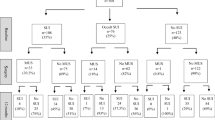Abstract
Introduction and hypothesis
The objectives of this study were to evaluate the incidence of postoperative stress urinary incontinence (SUI) after laparoscopic sacrocolpopexy (LSCP) in women with negative preoperative prolapse reduction stress testing (PPRST) and to identify associated risk factors.
Methods
This was a retrospective cohort study comprising women who consecutively underwent double-mesh LSCP without concomitant SUI surgery after a negative PPRST at a tertiary referral center. Negative PPRST was defined by the absence of SUI during cough testing and urodynamic studies with prolapse reduction.
Results
Fifty-five patients were assessed in the final analysis. No significant complication was encountered during and after LSCP. Mean follow-up was 25 ± 11 (range 12–48) months. No patient developed recurrent pelvic organ prolapse (POP) or mesh erosion at last follow-up. Thirty (54.5 %) patients reported the symptom of SUI (subjective SUI) postoperatively, 13 (23.6 %) had a positive cough test (objective SUI) at last visit, and nine (16.4 %) underwent a sling procedure. In univariate analyses, advanced cystocele (stage 3–4) and a history of patient-reported SUI before surgery were associated with a higher risk of postoperative subjective and objective SUI after LSCP. Multivariate analyses identified preoperative SUI as the sole independent predictor of subjective SUI [risk ratio (RR = 4.03; 95% confidence interval (CI) = 1.16–14.09), objective SUI, (RR = 4.67; 95% CI = 1.14–19.23), and subsequent anti-SUI surgery after LSCP (RR = 6.17; 95% CI = 1.30–29.41).
Conclusions
SUI is far from uncommon in women after LSCP despite negative PPRST, especially in those with advanced cystocele and a history of SUI preoperatively; after at least 1 year of follow-up, approximately one in six women eventually underwent a sling surgery. These data are useful for counseling patients.


Similar content being viewed by others
References
Olsen AL, Smith VJ, Bergstrom JO, Colling JC, Clark AL (1997) Epidemiology of surgically managed pelvic organ prolapse and urinary incontinence. Obstet Gynecol 89:501–506
Bai SW, Jeon MJ, Kim JY, Chung KA, Kim SK, Park KH (2002) Relationship between stress urinary incontinence and pelvic organ prolapse. Int Urogynecol J Pelvic Floor Dysfunct 13:256–260
Roovers JP, Oelke M (2007) Clinical relevance of urodynamic investigation tests prior to surgical correction of genital prolapse: a literature review. Int Urogynecol J Pelvic Floor Dysfunct 18:455–460
van der Steen A, van der Ploeg M, Dijkgraaf MG, van der Vaart H, Roovers JP (2010) Protocol for the CUPIDO trials; multicenter randomized controlled trials to assess the value of combining prolapse surgery and incontinence surgery in patients with genital prolapse and evident stress incontinence (CUPIDO I) and in patients with genital prolapse and occult stress incontinence (CUPIDO II). BMC Womens Health 10:16
Rosenzweig BA, Pushkin S, Blumenfeld D, Bhatia NN (1992) Prevalence of abnormal urodynamic test results in continent women with severe genitourinary prolapse. Obstet Gynecol 79:539–542
Reena C, Kekre AN, Kekre N (2007) Occult stress incontinence in women with pelvic organ prolapse. Int J Gynaecol Obstet 97:31–34
Ballert KN, Biggs GY, Isenalumhe A Jr, Rosenblum N, Nitti VW (2009) Managing the urethra at transvaginal pelvic organ prolapse repair: a urodynamic approach. J Urol 181:679–684
Brubaker L, Cundiff GW, Fine P et al (2006) Abdominal sacrocolpopexy with Burch colposuspension to reduce urinary stress incontinence. N Engl J Med 354:1557–1566
Borstad E, Abdelnoor M, Staff AC, Kulseng-Hanssen S (2010) Surgical strategies for women with pelvic organ prolapse and urinary stress incontinence. Int Urogynecol J 21:179–186
Visco AG, Brubaker L, Nygaard I et al (2008) The role of preoperative urodynamic testing in stress-continent women undergoing sacrocolpopexy: the Colpopexy and Urinary Reduction Efforts (CARE) randomized surgical trial. Int Urogynecol J Pelvic Floor Dysfunct 19:607–614
Elser DM, Moen MD, Stanford EJ et al (2010) Abdominal sacrocolpopexy and urinary incontinence: surgical planning based on urodynamics. Am J Obstet Gynecol 202(375):e371–e375
Kasturi S, Diaz SI, McDermott CD et al (2011) De novo stress urinary incontinence after negative prolapse reduction stress testing for total vaginal mesh procedures: incidence and risk factors. Am J Obstet Gynecol 205(487):e481–e484
Villet R (1995) Les prolapsus génitaux. In: Villet R, Buzelin J-M, Lazorthes F (eds) Les troubles de la statique pelvipérinéale de la femme. Vigot, Paris, pp 119–140
Haylen BT, de Ridder D, Freeman RM et al (2010) An International Urogynecological Association (IUGA)/International Continence Society (ICS) joint report on the terminology for female pelvic floor dysfunction. Int Urogynecol J 21:5–26
Kenton K (2011) The value of the preoperative prolapse reduction stress test in women without stress incontinence symptoms undergoing vaginal prolapse surgery with or without a TVT: Results of the OPUS trial. Neurourol Urodyn 30:870–871
Ramanah R, Ballester M, Chereau E, Rouzier R, Darai E (2012) Effects of pelvic organ prolapse repair on urinary symptoms: a comparative study between the laparoscopic and vaginal approach. Neurourol Urodyn 31:126–131
Park J, McDermott CD, Terry CL, Bump RC, Woodman PJ, Hale DS (2012) Use of preoperative prolapse reduction stress testing and the risk of a second surgery for urinary symptoms following laparoscopic sacral colpoperineopexy. Int Urogynecol J 23:857–864
Funding sources
None
Conflicts of interest
None
Author information
Authors and Affiliations
Corresponding author
Rights and permissions
About this article
Cite this article
Leruth, J., Fillet, M. & Waltregny, D. Incidence and risk factors of postoperative stress urinary incontinence following laparoscopic sacrocolpopexy in patients with negative preoperative prolapse reduction stress testing. Int Urogynecol J 24, 485–491 (2013). https://doi.org/10.1007/s00192-012-1888-7
Received:
Accepted:
Published:
Issue Date:
DOI: https://doi.org/10.1007/s00192-012-1888-7




